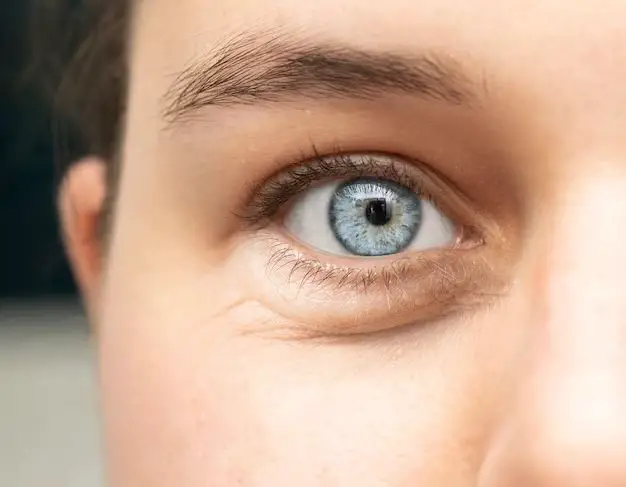Eyes come in a stunning array of colors and patterns. While brown and blue eyes are the most common, eye colors like green, amber, or hazel also exist. One particularly striking eye color is blue gray. But do blue gray eyes really exist? Let’s explore the genetics, causes, and characteristics of this mesmerizing eye color.
What causes blue gray eyes?
The color of our eyes depends on how much of the pigment melanin is present. Brown eyes contain a lot of melanin, while blue eyes contain very little. Blue gray eyes fall somewhere in between. They contain a medium amount of melanin that gives them a blueish gray appearance.
But what makes eyes contain different levels of melanin in the first place? The major factor is genetics. The pigmentation of your eyes is determined by the genetic variants you inherit from your parents.
The main gene involved is called HERC2. This gene regulates the expression of a gene called OCA2, which is crucial in melanin production. Certain variants of HERC2 and OCA2 reduce melanin levels and result in blue or blue gray eyes.
However, genetics alone don’t determine your eye color fully. Environmental factors can also play a role. For example, your eye color may darken slightly with age as melanin levels increase. Certain health conditions or medications may also affect melanin production. But genetics remain the key factor in whether someone has blue gray eyes from birth.
Prevalence of blue gray eyes
Blue gray eyes are relatively uncommon globally. Here are some estimates on the prevalence of different eye colors worldwide:
| Eye Color | Global Prevalence |
|---|---|
| Brown | 79% |
| Blue | 8% |
| Amber | 5% |
| Green | 2% |
| Gray | 1% |
| Hazel | 5% |
As you can see, purely gray eyes are very rare at just 1% of the population. Blue gray eyes are likely even less common, though the exact statistics are unknown. But while globally uncommon, blue gray eyes are more prevalent in certain ethnic groups and parts of the world.
Ethnic distribution of blue gray eyes
Blue and gray eye colors are most common among Caucasian populations, especially those of Northern and Eastern European descent. Here are some populations where blue gray eyes are more frequently seen:
- People of Irish, Scottish or English descent
- Northern Europeans such as Scandinavians and Balts
- Slavs from countries like Russia, Poland, and Ukraine
- Ashkenazi Jews
In contrast, blue gray eyes are much rarer among those of Asian, African, or Hispanic heritage. But anyone of any ethnicity can potentially have blue gray eyes if they inherit the right genetic variants.
Unique properties of blue gray eyes
So what makes blue gray eyes so dazzling and distinct? Here are some of their unique properties:
- Distinct grayish-blue color – Unlike pure blue eyes, blue gray eyes have a darker, grayish cast to them that sets them apart.
- Reactivity to lighting – Blue gray eyes can change from blue to gray depending on the lighting conditions. This ability to shift color makes them extra striking.
- Muted tone – They lack the vivid tones of blue eyes and have a more subdued, muted quality.
- Intensity – While muted, blue gray eyes often have an intense, piercing gaze.
- Patterns – Blue gray eyes commonly have speckles, streaks, or flecks of darker gray, blue or brown.
This blend of qualities gives blue gray eyes an icy, mysterious vibe. They can shift between cool shades of blue and steely grays, often with intriguing patterns scattered throughout.
How light affects blue gray eyes
One of the most fascinating aspects of blue gray eyes is how they change based on lighting conditions. Here is how different types of light affect them:
| Lighting | Effect on Blue Gray Eyes |
|---|---|
| Natural daylight | Brings out more blue tones |
| Overcast or shade | Makes eyes appear darker gray |
| Indoor fluorescent lights | Gives eyes a paler, icier blue cast |
| Yellow incandescent bulbs | Warms eyes toward grayish-brown |
As you can see, blue gray eyes are chameleonic and can shift on a color spectrum from light blue to charcoal gray. This mercurial nature makes them especially striking and unique.
Comparison to other eye colors
To better understand blue gray eyes, it helps to compare them to similar eye colors:
| Eye Color | Comparison to Blue Gray |
|---|---|
| Blue | Blue eyes are a vivid, pure blue while blue gray eyes are a muted blue-gray |
| Gray | Gray eyes lack the blue hues of blue gray eyes |
| Hazel | Hazel eyes shift between green and brown rather than blue and gray |
| Green | Green eyes have more yellow/golden flecks than blue grays |
So in summary, blue gray eyes are distinct from other light eye colors in their specific muted bluish-gray appearance that shifts based on lighting conditions.
Conclusion
Blue gray eyes undoubtedly exist, even if they are one of the rarest eye colors. Their gorgeous bluish-gray appearance, reactive nature, and intense gaze make them truly stunning. So next time you come across someone with blue gray eyes, take a moment to appreciate their truly unique and beautiful eye color.


